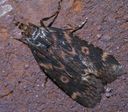Pyralinae
Pyralinae
Classification
- Phylum: Arthropoda
- Subphylum: Hexapoda
- Class: Insecta
- Order: Lepidoptera
- Superfamily: Pyraloidea
- Family: Pyralidae
- Subfamily: Pyralinae
Pronunciation
How to pronounce Pyralinae: /ˌpaɪrəˈlaɪniː/
These audio files are automatically generated. While they are not always 100% accurate, they are a good starting point.
Images






Summary
Pyralinae is a subfamily of snout moths within the family Pyralidae, known for its relatively small number of species in the Americas and worldwide distribution. This subfamily includes species that can become pests of stored goods and has a range of ecological roles depending on their larval feeding habits.
Physical Characteristics
Mid-sized to smallish moths with cryptic coloration, generally with various hues of brownish colors. Females have a short genital ductus bursae, and the corpus bursae extends forward only slightly beyond abdominal segment 7.
Identification Tips
Distinguished from relatives by possessing forewing vein 7 and having hindwing veins 7 and 8 unjoined as adults.
Habitat
Worldwide distribution, although they are rather rare in the Americas and have limited diversity in the Australian region.
Distribution
Worldwide, with notable species found in North America.
Diet
Caterpillar larvae of many Pyralinae can utilize unusual food sources; some species are pests of stored food products. For instance, Pyralis farinalis and Aglossa pinguinalis are known to infest stored grains and fats.
Life Cycle
Specific details about the life cycle are not provided, but larvae are known to feed on a variety of food sources including leaf matter.
Reproduction
Adult females possess a short genital ductus bursae, indicative of their reproductive structure.
Ecosystem Role
Some caterpillar species are leaf feeders, while others can be pests of stored goods, indicating a role in both ecological communities and agriculture.
Economic Impact
Certain species, such as Pyralis farinalis (meal moth) and Aglossa pinguinalis (grease moth), are pests of stored food products and can have significant economic impact due to contamination or damage.
Health Concerns
Some Pyralinae species can be harmful as pests due to their presence in stored human food supplies, which can lead to contamination.
Evolution
The systematics and taxonomy of Pyralinae are somewhat provisional, with ongoing studies aimed at clarifying their phylogenetic relationships. They belong to the advanced snout moth lineage.
Similar Taxa
Misconceptions
The genus Micronix was previously associated with this subfamily but is believed to belong to Crambidae, demonstrating the fluid nature of taxonomic classifications.
Tags
- Pyralinae
- snout moths
- Lepidoptera
- Pyralidae